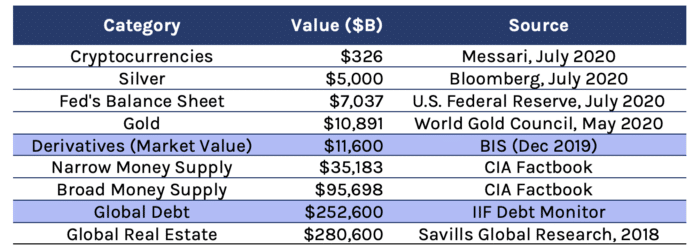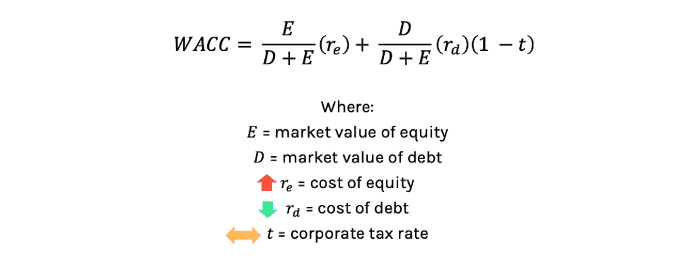
The crypto-secured loans started in 2017, and since then, they grow fast. A three-part series presents the past, the present, and the future of the crypto credit market. This report reviews the history, or more specifically, the credit market’s development in the crypto ecosystem.
The world loves leverage. Liabilities are the magic that supports economic growth since the beginning of time. Although we are far away from the days of the iron bank – a retrospective to the Games of Thrones fans among you – the global loans by far are the most significant class of investment. No matter whether it’s government debt, corporate debt, derivatives, consumer debt, or any permutation of it, leverage is the lubricating agent that keeps the wheels of the global machine going.
Illustration 1: The global asset base (sorted by size)

Bitcoin is used as a hedge against the devaluation of fiat currencies by governments and their central banks. When one sees Chairman Powell busy with the money printer (brrr), the sharp contrast between bitcoin and fiat is obvious. Bitcoin is only digital. Therefore, we expect that in the upper tables of the global financial assets, this currency will conduct like gold and increase in value on the condition of rising demand. It doesn’t behave like fiat or other cryptocurrencies, which expand the supply to meet the demand.
The investors that hold bitcoin are rational people, though. As we have witnessed bitcoin’s financialization with the bitcoin derivative market’s exponential growth, including synthetic, cash-settled, and digital instruments, the bitcoin credit market growth exponentially quarter by quarter.
Please, enter out the magical time machine and let us transport you to 2017 … ( no, if honestly, it was two crypto eons before…)
A lesson in the history of crypto finance
If you are a fan of modern economics, you should be familiar with the pricing model for investment goods, maybe you know the expression WACC is whack, and you’ve heard about Miller and Modigliani’s works. We are referring to MM63 only for the reason of introducing the debt costs or r(d), which influences how the enterprises make the financial decisions.
Illustration 2: Are equity and loan capitals equivalent? The pitfalls of CAPM

So, why are we referring to WACC? If we look in retrospect, the business in the crypto ecosystem was financed purely by equity costs. As one of the few crypto-investors in 2015, we can assert that the idea of loan financing didn’t exist in reality. The prices of the equity capital were variable, but in general, relatively high. The average dilution in one round of financing was between 20-40%, depending on your business model, jurisdiction, and ability to sell the assessment to investors. For most businesses, access to capital was fundamentally restricted for the E, equity cost, and a high rate for r(e).
Given that bitcoin was traded in the range from USD 200 to 300 for a lengthy timeframe, and previously was about USD 1.200, the founders didn’t want to sell their coins for hard cash to finance working capital. Some businesses which accepted the fund flows obliged themselves to a clear “no.” They used a part of their financing to buy MORE bitcoin and held bitcoin on their balance instead of converting it, as they thought that the cost of bitcoin would rise. In 2017 and 2018, many businesses ran huge financing rounds to the “revenue” key figures, further fueled by the cost rise of the underlying assets, bitcoin and Ether.
A unicorn in the crypto environment is a financial services company, which got their unicorn status partially based on an increase in the value of underlying assets, which it achieved independently.
In 2017 the investors started thinking if they could finance the businesses with short-term needs for working capital. It had no sense to create heavily watered, costly equity capital to fund a short-term need, which emerged through the short-term disbalance in cash flows. Some of the businesses already had cryptocurrencies on their balance, so giving loans against crypto securities presented a poor-risk possibility to provide loans on modest rates to finance the growth possibilities. The trading desks with cash on their balance were in a good starting position to start with short-term capital for these businesses, mostly as they already were investors by their venture strategy.
As bitcoin, in six months, grew from about USD 700, above USD 1200, and up to USD 10,000, the market for crypto credits increased dramatically. The businesses in the early phase of their investment portfolios with the limited liquid funds on their balance were in a position that enabled them to finance their current assets in the new way, which created a market for loans. And so, the market for the crypto secured loan was born, and r(d) appeared. And what is more important: since the loans were secured by bitcoin, a fluid and easy to sell financial asset, the necessary risk level was very low. It shouldn’t surprise anyone that today’s interest rates for the crypto-secure credits are not higher than other kinds of business loans. In some cases, the crypto companies can take loans at better interest rates than other technology startups.
Trip 1 – Margin trading
We cannot ignore that the margin trading in the crypto environment has always existed. In the course of this article, we’ll touch upon not the loan interests of traders, but the risk of the asset-backed lending market for the financing of businesses, or with the application of the corporate finance equation a la WACC. The trading environment was an engine for the innovation of the business models in the crypto area. The crypto secured loan model was popularized by the early trading platforms that gave loans against crypto securities.
The last point here: introducing a robust market for asset-secured loans has a decisive meaning for the crypto ecosystem and many businesses in this ecosystem.
The reduction of capital costs
The fact that the average capital costs sank considerably was strongly connected with the growing loan market. The interest rates for the admission of dollars through bitcoin securities were between 8 and 12%, which was more attractive than 20-40% watering with equity capital. And don’t forget the significant tax benefits of loan financing that sugared the business. The access to the capital was simplified since here appeared more entities that could serve this loan market.
As for the risks, today, there is a vast majority that ultimately secures institutional crypto loans as a rule in the ration between 1.25 and triple of the loan sum, depending on the volatility of the underlying financial assets. If you have securities, the value of which fluctuates hard, you can reserve no margin calls round the clock.
Trip 2 – Venture Dept (Risk Debt)
Five years ago, the risk loans were considerably less developed compared to today. The only company that did that in significant volumes was WTI that run the due diligence assessments to the companies it supported. WTI accepted warrants from the businesses with high growth indicators and conducted like a venture capitalist, that is converted those warrants to equity capital in the next financing rounds. However, WTI gave loans only to SaaS businesses with foreseeable revenues. They didn’t want to provide loans for crypto businesses that were mostly dependent on the underlying financial assets’ cost.
Today, there are a lot of venture credit companies and funds, for example, Indie.vc, Greensill, Sandton, and many others. The rounds that consist of equity and loan capitals are far more frequent. For example, a fin-tech company Pile gathered USD 65 M in series A, which consisted of USD 10M of equity funds and USD 55 M of loan costs.
Today an effective, risk-free loan against crypto secured credits still gives 8-12% APY. Given that lending is going to zero in traditional markets for LIBOR + 1, or if you have access to the printer, we expect the rates of crypto loans to fall as the capital hunt for returns increases.
This brings us to the topic “Yield Farming.”
In the world where the capital is available in abundance, but the returns are scarce, the investors are ready to move the risk curve further outwards to achieve yields. We’ll get to this soon!
Visit mooninites: crypto loans grow exponentially!

Enter the Delorean, and let’s jump to July of 2019. At this point, the crypto loans existed for almost two years. While the crypto loans started with brokers and existing desks, the crypto community learned fast that they didn’t need a team of expensive dealers to connect the sellers and buyers of risks. One could use the magic of the internet to satisfy this market, and one could use the financial basis founded on Ethereum to develop the new kinds of loan instruments. The first product of this kind was the margin loan product offered by Maker.
The loan with an on-chain margin loan was simple. A borrower locks Ether as security and takes dollars in Stablecoins Dai (a synthetic dollar, to say so). As long as the value of the secured Ether remains over 150% of the USD loan, no payment is demanded from the borrower. If it falls under this threshold, the secured Ether will be liquidated to pay the loan, which ensures that the lender doesn’t suffer a credit loss, and the excess will be refunded to the Ether wallet of the borrower. The Maker system was massive proof of the open ecosystem concept. It showed how the financial incentive and programmable money, based on the Ethereum network, enable an automated loan market that follows programmed rules, but not manually entered index.
Through the provision of liquidity to borrowed stablecoins, that are ready to overinsure their existing “unproductive” crypto stocks, on-chain crypto loaning opened new dimensions – a possibility to obtain leverage without liquidating their bare and growing assets. On the other side, giving loans in these markets offered those with investments seeking a return. These floating rates far exceeded the catastrophic daily rates provided by traditional banks in return for taking more significant risks. These risks include log risk, smart contracts risk, liquidity risk, and asset price volatility risk. Naturally, there are numerous problems with different crypto secured loan platforms that return to various constructional flaws – among them technical mistakes with Smart Contracts and behavioral change cases that lead to unforeseen arbitrage possibilities. The Maker experiment proved that a) this system functioned, and b) it increased the capital availability and efficiency drastically.
The dozens of platforms that function like Maker grow very fast, almost overnight.
Over time, Maker developed from single security in the form of Ether to a multi-security. Today, the crypto market includes an active interest rate market for borrowers and lenders of different assets in exotic new ways …
Which brings us to the present! In the second part, we outline new models for alternative loans implemented today in the world of “decentralized finance” or DeFi.

